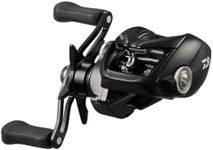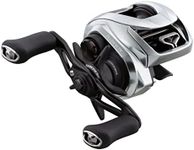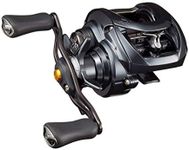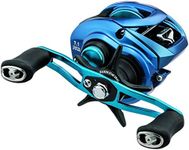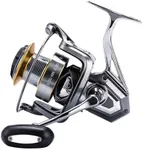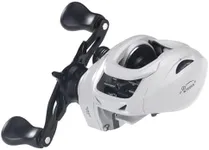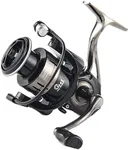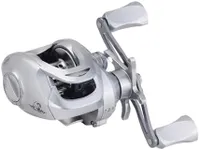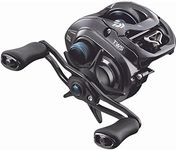Buying Guide for the Best Daiwa Baitcasting Reels
Choosing the right baitcasting reel can significantly enhance your fishing experience. Baitcasting reels are known for their precision and control, making them a popular choice among experienced anglers. When selecting a baitcasting reel, it's important to consider several key specifications to ensure you get the best fit for your fishing style and needs. Understanding these specs will help you make an informed decision and enjoy a more successful fishing trip.Gear RatioThe gear ratio of a baitcasting reel indicates how many times the spool rotates with each turn of the handle. This spec is crucial because it affects the speed and power of your retrieve. Gear ratios are typically divided into three segments: low (5.1:1 to 5.4:1), medium (6.1:1 to 6.4:1), and high (7.1:1 and above). Low gear ratios provide more power and are ideal for heavy lures and deep diving crankbaits. Medium gear ratios offer a balance of speed and power, suitable for a variety of techniques. High gear ratios allow for fast retrieves, making them perfect for topwater lures and techniques that require quick line pick-up. Choose a gear ratio based on the type of fishing you plan to do most often.
Drag SystemThe drag system on a baitcasting reel controls the amount of resistance a fish feels when it pulls on the line. This is important for preventing line breakage and ensuring you can effectively fight and land fish. Drag systems are measured in pounds of maximum drag. For light freshwater fishing, a drag system with up to 10 pounds of drag is usually sufficient. For larger freshwater species or light saltwater fishing, look for a drag system with 10-20 pounds of drag. For heavy saltwater fishing, a drag system with over 20 pounds of drag may be necessary. Consider the size and strength of the fish you target to determine the appropriate drag system for your needs.
Line CapacityLine capacity refers to the amount of fishing line that the reel can hold, usually measured in yards for a specific line weight. This spec is important because it determines how much line you have available to cast and fight fish. If you are fishing in open water or targeting species that make long runs, a reel with higher line capacity is beneficial. For freshwater fishing, a line capacity of 100-150 yards of 10-12 lb test line is typically adequate. For saltwater or larger species, you may need a reel that holds 200 yards or more of heavier line. Match the line capacity to the type of fishing and the size of fish you expect to encounter.
Brake SystemThe brake system on a baitcasting reel helps control the speed of the spool during a cast, reducing the likelihood of backlash (tangles). There are two main types of brake systems: magnetic and centrifugal. Magnetic brakes are easier to adjust and are great for beginners, while centrifugal brakes offer more precise control and are preferred by experienced anglers. Some reels feature dual brake systems that combine both types for maximum control. If you are new to baitcasting, a reel with a magnetic brake system may be more user-friendly. For more experienced anglers, a centrifugal or dual brake system can provide better casting performance.
BearingsBearings in a baitcasting reel affect the smoothness and performance of the reel. They are usually made of stainless steel or ceramic and are measured by the number of bearings in the reel. More bearings generally mean smoother operation, but quality is also important. Reels with 5-7 bearings are common and provide good performance for most anglers. High-end reels may have 10 or more bearings for ultra-smooth operation. Consider the quality and number of bearings based on how often you fish and the level of performance you desire. For occasional fishing, a reel with fewer bearings may suffice, while frequent anglers may prefer a reel with more bearings for enhanced smoothness.
